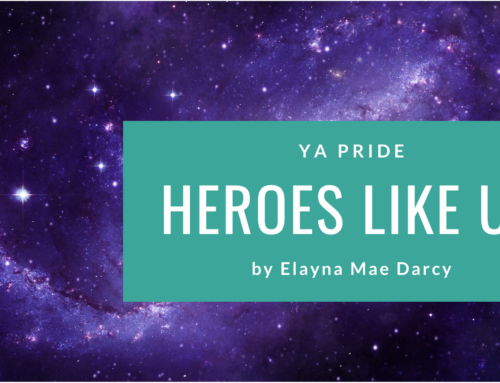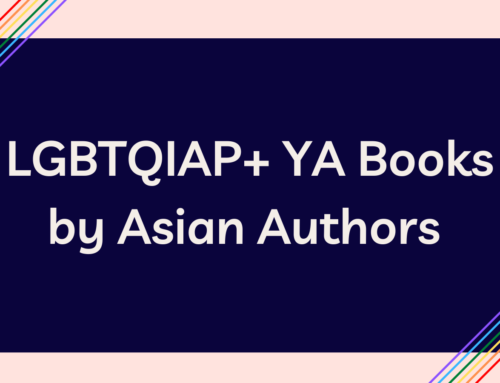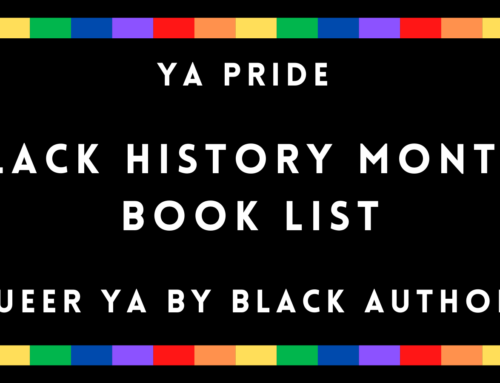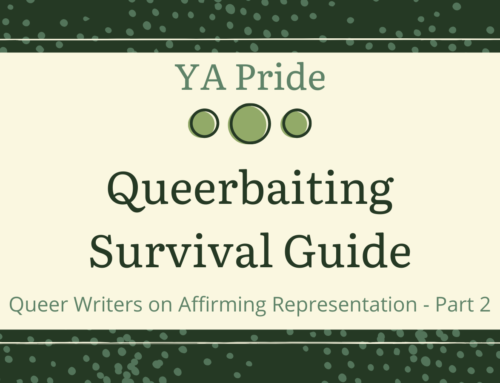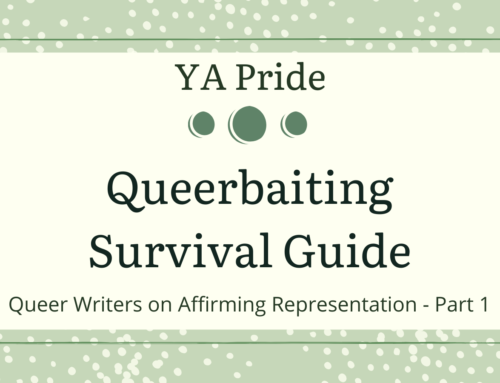After seeing an ask about speculative fiction with LGBTQ+ protagonists on the Gay YA tumblr a few weeks ago, I got curious, so I did what I often do in circumstances like these: I went through the masterlist to figure out just how much LGBTQ+ speculative fiction was on it. Thinking about speculative fiction numbers got me thinking about other numbers, so I thought it might be interesting to do a gender breakdown as well. This turned into a slightly more involved project (“more involved” meaning “I had to count more books”, basically). These numbers are based on the list as it stood on 21 April, 2015; they would look (slightly) different if recalculated today.
Totals
I’m going to go down the list from most books to least books.
Gay: 315 books
- male author: 174.5 (55.4%)
- female author: 130.5 (41.4%)
- non-binary author: 0 (0%)
- multi-author anthology: 7 (2.2%)
- anonymous: 1 (0.3%)
- I couldn’t find out: 3 (1.0%) (two books by M.C. Lee and one by R.J. Seeley)
While a majority of books about gay male characters are written by men, a significant portion of them are written by women (a far, far greater percentage than the numbers for books about lesbians written by men, as we’ll see in a moment).
That said, my initial perception that the majority of the books in the Gay section of the masterlist were written by women was, obviously, very wrong — it’s clear I fell victim to the 17%/33% fallacy (if you’re reading this, are a man, and haven’t heard about this, I’d highly recommend reading the article; it really opened my eyes to the limitations of my perception and is the reason that in contexts like this my approach is to actually count so I have accurate numbers instead).
I’d be very interested to hear from authors about why they chose to write the stories they wrote (as opposed to writing stories about non-straight female characters).
Lesbian: 203 books
- male author: 13 (6.4%)
- female author: 172 (84.7%)
- non-binary author: 1 (0.5%) (S.J. Adams)
- multi-author anthology: 15 (7.4%)
- I couldn’t find out: 2 (1.0%) (two books by Ari Bach)
These percentages become even starker if you exclude the anthologies: over 90% of the non-anthologies were written by women.
Bisexual: 81 books
- male author: 21.5 (26.5%)
- female author: 58.5 (72.2%)
- non-binary author: 0 (0%)
- multi-author anthology: 1 (1.2%)
A further breakdown of the bi books by the gender of the bi character (and character gender vs. author gender) would be very interesting, but that will have to wait for another time.
Transgender: 38 books
- male author: 6.5 (17.1%)
- female author: 26.5 (70.0%)
- non-binary author: 2 (5.3%) (one book by Sassafras Lowry and one by Rae Spoon)
- multi-author anthology: 3 (7.9%)
The same note as for the bi books applies here, as well.
Asexual/Aromantic: 19 books
- male author: 2 (11%)
- female author: 17 (89%)
- non-binary author: 0 (0%)
- multi-author anthology: 0 (0%)
Caveat: the ace/aro section of the masterlist includes non-YA books, in deference to the rarity of ace/aro representation in YA, so take these numbers with a grain of salt.
Intersex: 6 books
- male author: 0 (0%)
- female author: 6 (100%)
- non-binary author: 0 (0%)
- multi-author anthology: 0 (0%)
There are so few books with intersex characters. Hopefully that will change in future.
Genre
I’ve included a gender breakdown here, as well. For the purposes of this list, I counted all forms of speculative fiction: high fantasy, urban fantasy, paranormal stuff, science fiction, postapocalyptic and/or dystopian books, magical realism, etc. Not included are things like thrillers, historical fiction, sports books, and the like. Again, I’m going to go through by number of books.
Gay: 76 of the 315 gay books were speculative fiction (24.1%)
- male author: 39 (51.3% of genre)
- female author: 33 (43.4% of genre)
- multi-author anthology: 2 (2.6% of genre)
- I couldn’t find out: 2 (2.6% of genre) (two books by M.C. Lee)
Lesbian: 58 of the 203 lesbian books were speculative fiction (28.6%)
- male author: 3 (5.2% of genre)
- female author: 48 (82.8% of genre)
- multi-author anthology: 5 (8.6% of genre)
- I couldn’t find out: 2 (3.4% of genre) (two books by Ari Bach)
Bisexual: 40 of the 81 bisexual books were speculative fiction (49.4%)
- male author: 5 (12.5% of genre)
- female author: 35 (87.5% of genre)
Asexual/Aromantic: 17 of the 19 ace/aro books were speculative fiction (89%)
- male author: 1 (6% of genre)
- female author: 16 (94% of genre)
As above, these statistics are perhaps a bit dubious considering that the masterlist includes non-YA books with ace/aro characters.
Transgender: 9 of the 38 transgender books were speculative fiction (23.7%)
- male author: 2 (22% of genre)
- female author: 7 (78% of genre)
Intersex: 2 of the 6 intersex books were speculative fiction (33%)
- female author: 2 (100% of genre)
There are so few of these that these statistics mean nothing, basically.
Comments
Excluding asexual/aromantic and intersex on the grounds that there are too few of them to make any real judgments, the percentage of genre fiction is pretty consistently around 25% for gay, lesbian, and trans books.
So what’s up with the bi books? I mean, that’s awesome if you’re looking for speculative fiction about bi characters (and really, is anyone not?), but still: almost 50% of the books on the masterlist about bi characters are speculative.
This raises two questions that are two sides of the same coin: first, why is it that we can more easily imagine bi characters in speculative contexts than in the real world? And, relatedly: why is it that gay, lesbian, and trans characters are limited (relatively speaking) to realistic (or at least grounded in the real world) fiction?
I think the answers to those questions are related in much the same way the questions are:
- the dominant narrative about LGBTQ+ youth is the coming out story, prototypically about gay men, lesbians to a lesser extent, and more recently trans people (cf. Casey Plett’s excellent commentary on the “Rise of the Gender Novel“). Bi young people don’t fit as neatly into this narrative, so fewer versions of it are written.
- by the same token, the dominant narrative about LGBTQ+ youth is the coming out story about gay men, lesbians, and trans people. Speculative fiction plots don’t tend to leave as much room for this as realistic fiction does, so less speculative fiction about these groups is written because it’s harder to fit that dominant narrative into speculative stories.
The (relative) overrepresentation of bisexuality in speculative fiction worries me: it’s already easy enough for realistic media to refuse to say the word “bisexual”. Moving to a fantasy world where contemporary labels for sexuality aren’t used or don’t apply can be liberating, but it can also be an uncomfortably convenient way to not engage with real-world questions about identity. (See: Editor’s Note)
The (relative) underrepresentation of gay, lesbian, and trans characters in speculative fiction has been extensively discussed elsewhere, and I don’t have much to add that hasn’t been said elsewhere, better, before. Speculative fiction allows members of marginalized groups to imagine possibilities for themselves beyond what the dominant group(s) acknowledge, and that’s incredibly important (N.K. Jemisin has an amazing essay on representation that you should read immediately).
This is not at all to say that realistic fiction isn’t important, because it is. If we take one thing away from this post, let it be that there just isn’t enough LGBTQ+ YA being published. The Gay YA Masterlist is not a complete list, by any means, but it’s fairly comprehensive, and it’s also short enough that it’s not unreasonable for me to sit down and count every book on it. Malinda Lo estimated in 2013 that only “1.9% to 2.4% of YA books published in 2013 include LGBT main characters or are about LGBT issues”.
Realistically, there just aren’t enough LGBTQ+ YA books being published for any of these numbers to be more than vaguely suggestive of questions or trends. How meaningful is it to say more books about bi characters in speculative contexts are being published when only a handful of books about bi characters are released every year? Or that there are “too many” coming out stories when major publishers released only 24 LGBTQ+ YA books total in 2014?
We desperately need more stories. In N.K. Jemisin’s words (seriously, read the essay I linked to above):
We all have futures. We all have pasts. We all have stories. And we all, every single one of us, no matter who we are and no matter what’s been taken from us or what poison we’ve internalized or how hard we’ve had to work to expel it —
— we all get to dream.
EDITOR’S NOTE: There’s been some confusion regarding the commentary on bisexual representation this post, so to clarify: This post is not an attempt to suggest that there is too much bisexual representation in speculative fiction. Rather, it intends to ask why there is comparatively less bisexual representation within realistic fiction, and explores some possible answers. The commentary within this post is regarding genre, not representation.
We believe bisexuality is comparatively underrepresented in queer YA, and want to see more bisexual characters in every genre. (Notice that, percentages aside, there are significantly fewer books featuring bisexual characters than books featuring gay or lesbian characters.) The post is not intended to discourage writers of speculative fiction that includes a bisexual character. As was said in this post: “If we take one thing away from this post, let it be that there just isn’t enough LGBTQ+ YA being published.” We need more queer stories of every kind, in every genre.
We apologize for any confusion or misunderstandings created, and invite anybody who still feels uncomfortable about the content in this post to get in touch with us at vee@gayya.org
